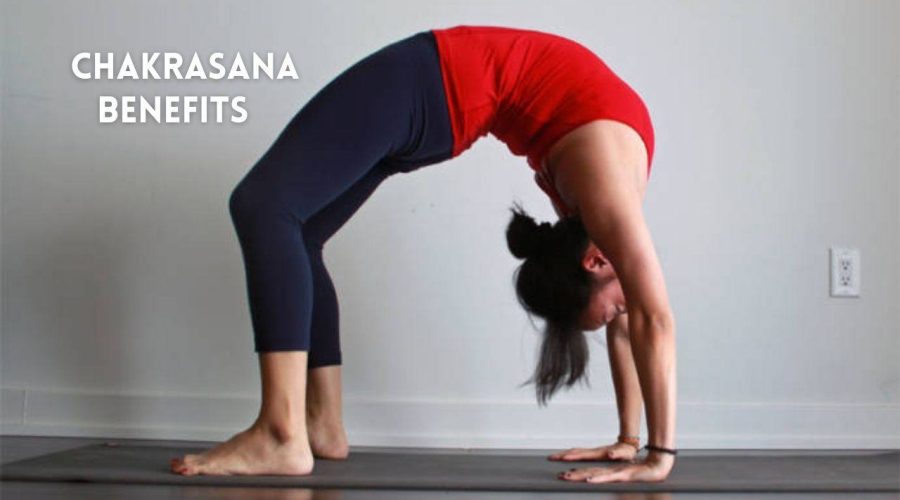Chakrasana (Urdva Dhanurasana) in Yoga: Know the Steps, Benefits, and Precautions
Chakrasana, also known as Urdva Dhanurasana, is a famous yoga movement that many people use to develop spine flexibility while also strengthening it. The ‘Wheel Pose,’ or as most people refer to it, the Upward Facing Bow Pose, is an element of Ashtanga Yoga, a type of yoga that improves heart health, relieves stress, burns fat, and doubles as a cardio workout, among other things. Sri K. Pattabhi Jois introduced this type of yoga in 1975, and it entails performing Ashtanga poses at a fast and continuous speed.
Chakrasana, also known as Urdhva Dhanurasana, is a posture of Ashtanga Yoga that is frequently practised to improve body and mind health. Chakrasana is supposed to align the seven chakras of the body: Muladhara (the Root Chakra), Svadhisthana (the Sacral Chakra), Manipura (the Navel Chakra), Anahata (the Heart Chakra), Vishuddha (the Throat Chakra), Ajna (the Third-Eye Chakra), and Sahasrara (the Crown Chakra) (the Crown Chakra).
According to ancient cultures, having these chakras aligned equals an even and healthy flow of energy that improves body and mind wellness. Flexing backwards by arching your back into a bow and touching your palms to the floor is the goal of this asana. Chakrasana is a yoga pose that improves flexibility and muscle strength. Apart from increasing your body’s energy, it targets the spine, wrists, intercoastal muscles, quadriceps, and hip flexors.
Steps to do Chakrasana
It’s ideal to do this four to six hours after you’ve eaten. The reason for this is that digested food gives the body energy, which is essential for this yoga routine. Yoga sessions around sunrise are recommended, but if that is not possible, Chakrasana can also be done in the evening.
- Place yourself on the ground. Keep your knees propped up and your feet’s flats firmly on the ground, closer to your bottom.
- Make sure your fingers are fanned out and your hands are behind your shoulders, near your ears.
- Make adjustments to your physique till you’re at ease. Use your legs to support your weight and prop up your lower body.
- After that, press your feet and palms together and raise your body upwards, trying to arch it as far as possible.
- Allow your head to softly hang.
- Breathe slowly and evenly.
- Continue to hold that position while focusing on your breathing. Gently drop your back to the ground, concentrating on even breathing.
- Allow your body to rest for a few minutes before returning to any other exercise or activity.
Precautions to follow when performing Chakrasana
Chakrasana works practically all of your body’s muscles and, if not done correctly, can be a strenuous workout. If you don’t practise yoga on a regular basis, here are some tips to keep in mind.
- If you have a high blood pressure problem, you should avoid this asana.
- We recommend avoiding this one if you have wrist difficulties like tendinitis or shoulder troubles because it puts a lot of pressure on your wrist.
- Avoid this yoga pose if you have fractured bones, damaged ligaments, a slipped disc, a neck injury, or any other physical illness.
Benefits of Chakrasana
- Flexibility and strength of the spine – In addition to strengthening the spine, it also lengthens and elongates the spinal cord. It’s generally known that as we become older, our skeletal frame begins to shrink; this asana aids in maintaining our posture and form.
- Regular practise helps to tone the abdomen region and minimise obliques and abdominal fat.
- Increases lung capacity and makes it easier for oxygen to move throughout the body by opening up the chest.
- Stimulates the neurological and endocrine systems – When the thyroid and pituitary glands are stimulated by the posture, joyful hormones are released. It both energises and relaxes you.
- This practice increases hip flexibility while stretching the hip.
- Improves cardiovascular health – As the chest is pushed out, the energy is activated and cardiovascular health improves.
- Arms, shoulders, and wrists are strengthened.
Frequently Asked Questions
1. How long will it take to do Chakrasana?
You can hold this Chakrasana stance for 30 seconds to 3 minutes, depending on your needs and capacity. Chakrasana benefits include strengthening your back muscles and toning your adrenals.
2. What is the benefit of Chakrasana?
Chakrasana, also known as Urdhva Dhanurasana, is a deep stretch for the chest, shoulder muscles, and hip flexors. The hamstrings and spinal extensors are also strengthened. Wheel Pose also has additional scientifically validated benefits. Improves the flexibility of the spine.
3. Who should not do Chakrasana?
If you have a back ailment, avoid this Yoga Pose. Blood pressure can be high or low. If you have any cardiac or spinal concerns, don’t do this. If you have a hernia, stay away from it.
4. Is Chakrasana good for weight loss?
Chakrasana Yoga stance is good for weight loss and fat burning from toes to fingers, and it’s especially good for burning abdominal fat. Chakrasana is an excellent asana that, when practised frequently, can help the body achieve optimum health.

